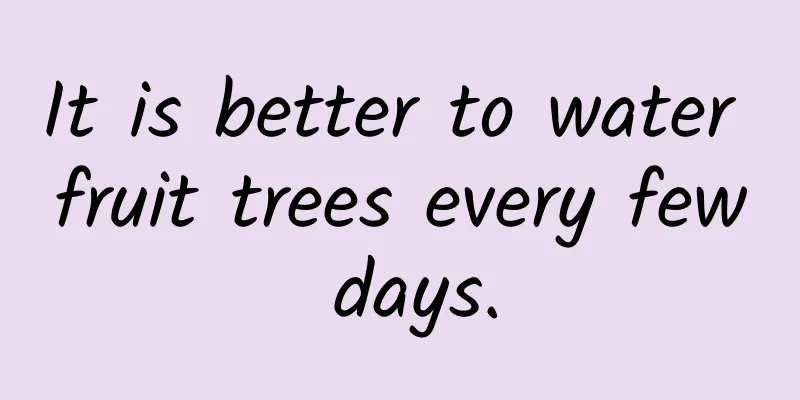Just learn one trick, and jasmine and bougainvillea will bloom 365 days a year, with branches full of flowers every time!

Bougainvillea blooms more: control water!Bougainvillea is suitable for planting in places with perennial warmth and plenty of sunshine, and does not require frequent watering. Tips for promoting flowering of bougainvillea: 1. Start controlling the water 40 days before flowering, and just sprinkle a little water around the bougainvillea to keep it in a state of withering for half a day and not withering for half a day. 2. Do not apply fertilizer when controlling water. After 3 weeks of water control, water the plant sufficiently, then loosen the soil and cut off the roots. Apply fertilizer once a week, such as bone meal. 3. When you resume watering, you can use 0.2% potassium dihydrogen phosphate solution once to make the flowers more concentrated. Jasmine blooms profusely: prune!Jasmine likes an environment with sufficient light. If conditions permit, it is best to grow it outdoors. If conditions do not permit, it should be placed in a sunny place for maintenance. Jasmine flower-promoting techniques: 1. When watering, you can add a little vinegar to the water, 1 to 2 drops will do. Alternatively, you can water the plant with 1:10 alum fertilizer once a week to keep the soil acidic. 2. Before the jasmine sprouts in spring, you can shorten last year's branches appropriately, leaving 10-15 cm at the base. 3. If the new branches grow vigorously, you should pinch off the top and buds when they are about 10 cm to promote the growth of secondary new shoots. To make Clivia bloom more: fertilize!The soil for Clivia must be loose, breathable and well-drained. The soil can be prepared by mixing leaf mold with peat soil and river sand. Clivia flower-promoting techniques: 1. When planting, use decomposed organic fertilizer as base fertilizer, such as decomposed cake fertilizer, chicken manure, etc. 2. During the peak growth season, apply more phosphorus and potassium fertilizers such as urea and bone meal, and less nitrogen fertilizer. 3. Appropriate foliar fertilizers such as urea, potassium dihydrogen phosphate, etc. can be sprayed. When using, pay attention to applying fertilizers thinly and frequently, and the concentration should not be too high. Cyclamen blooms more: repot!Cyclamen likes plenty of diffuse light, but cannot see strong sunlight. It is shade-tolerant, but cannot be kept in the shade for a long time. Cyclamen flowering promotion techniques: 1. Use fertile sandy loam with a lot of humus to grow cyclamen. It is best to replace the potting soil once a year. 2. Spring and autumn are the best time to fertilize cyclamen. You can apply thin fertilizers frequently and apply potassium dihydrogen phosphate appropriately every half a month. 3. Cyclamen is not resistant to high temperatures, and creating a low-temperature environment is conducive to flowering. The optimum temperature for cyclamen is around 20℃ during the day and around 10℃ at night. Make Begonia bloom more: fertilize!Begonia likes light, is slightly shade-tolerant, likes warmth and fears cold, and prefers a shady and humid environment and moist soil. Tips for promoting flowering of Begonia: 1. Apply thin fertilizers frequently. Do not apply fertilizers in winter and hot summer. Apply thin liquid fertilizers twice a month in spring and autumn, such as thin urea water, decomposed bean cake water, etc. 2. When the begonia is about to bloom, you need to apply more phosphorus and potassium fertilizers. After the flowers fade, pick off the remaining flowers and add some compound fertilizer. 3. In addition, maintaining the indoor temperature above 15℃ is also conducive to the year-round flowering of Begonia. Have you learned all these methods to promote flowering? Do you have any other good methods to promote flowering? Remember to tell Huahua~ |
Recommend
How to dwarf the bamboo-leaf begonia
Topping If we want to dwarf the bamboo begonia, w...
The difference between Sedum sedum and Sedum sedum
1. Difference in leaf color The fleshy leaves of ...
Nasturtium cultivation methods and precautions
1. Flower soil When growing nasturtiums, it is be...
What are the cultivation methods and precautions of Begonia
Begonia Introduction Begonia is a tree that can g...
Do blueberries like water? Are they water-loving plants?
Do blueberries like water? Blueberry prefers wate...
What are the cultivation methods and precautions of Catharanthus roseus?
Introduction of Vinca roseus Catharanthus roseus ...
Cultivation methods and precautions of azalea
1. Lighting Rhododendron likes bright diffuse lig...
How to grow osmanthus at home
Causes of poor growth The dormant temperature of ...
Planting flowers in the bedroom and living room, not planting them properly will harm the health of your family, you will regret it if you don't read it
These flowers are especially suitable for growing...
How many years does it take for a pecan tree to bear fruit?
The pecan tree has been planted for several years...
Bury a stick in the pot, and the soil will immediately become fertile, and the green ivy, Clivia... will grow like crazy as if they were injected with chicken blood!
Add some tea leaves to the soil and the green ivy...
Diseases and prevention methods of Eustoma
Diseases of Eustoma: Stem blight symptom Stem bli...
What is the best season to plant sweet potatoes? Sweet potato planting time and method
When planting sweet potatoes, the first thing to ...
How to grow Monstera in autumn
1. Pay attention to heat preservation It is relat...
Feng Shui Effects of Areca Palm
1. Place it in the living room The plant of Areca...









